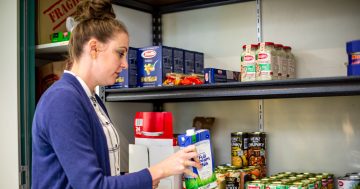
Cost of living pressures have forced some Canberrans to make difficult choices between bills and the basics. Photo: File.
Canberrans living on low incomes are the hardest hit in the country by the largest increase in cost of living in more than 20 years, according to a new report.
The 2022 ACT Cost of Living Report, released today (6 May) by the ACT Council of Social Service (ACTCOSS) shows low income households in the Capital have been impacted the most by significant increases in the prices of essential goods and services in the ACT.
ACTCOSS deputy CEO Adam Poulter said that, far from sharing in an economic and community recovery, more people were seeking support from ACT community sector organisations due to the rising cost of living and declining income support.
“In March 2022, the CPI recorded its largest annual rise since the year 2000. This week the RBA Governor said inflation is expected to rise even further this year,” he said.
“Over the past 12 months, Canberra’s community organisations have seen demand for support increase as households have struggled to stretch declining budgets to cover the rising costs of the basics.
“Over two thirds of community sector staff reported that in the past year levels of poverty and disadvantage had increased among the groups they support.”
Analysis of Canberra CPI data shows that over the past five years:
- Automotive fuel prices increased by 35 per cent;
- Electricity prices increased by 28 per cent;
- Gas prices increased by 24 per cent;
- Medical and hospital services prices increased by 21 per cent;
- Housing prices increased by 19 per cent;
- Education prices increased by 17 per cent;
- Meat and seafood prices increased by 16 per cent.
The sharp rise in the cost of living in the past 12 months coincided with the removal of temporary boosts to income report, which Mr Poulter said had lifted thousands of Canberrans out of poverty during the initial phase of the COVID-19 pandemic.
“It is estimated that since the phasing out of JobKeeper and the Coronavirus Supplement, the number of Canberrans living below the poverty line increased above 38,000 people, including 9000 children,” he said.
“Compared to a year ago, a single person on JobSeeker is receiving $93 less each week and living on just $46 a day. Their weekly income is now $138 below the poverty line. For a young person looking for work on Youth Allowance, their weekly income is now almost $200 below the poverty line.
“As called for by the Raise the Rate for Good campaign, we need the next Federal Parliament to raise the rate of working age payments to at least $70 a day so that everyone has enough to cover the basics while going through tough times.”
The 2022 ACT Cost of Living Report also shows that the Commonwealth Rent Assistance (CRA) is failing to protect most recipients from experiencing housing stress.
“The ACT has the highest proportion of CRA recipients receiving the maximum rate, and the highest proportion of recipients experiencing rental stress at 55 per cent. We need to see Commonwealth Rent Assistance increased by 50 per cent,” Mr Poulter said
“Canberra remains the most expensive capital city to rent a house or a unit and the ACT has the highest rate of rental stress among low-income private renters. Alongside a chronic lack of affordable private rental properties, the ACT has a shortage of over 5500 social and affordable housing dwellings.
“Addressing our housing affordability crisis will be a major focus for ACTCOSS in the lead up to the 2022-23 ACT Budget in August. We will be calling on the ACT Government to take action across a range of cost-of-living issues, including housing, transport, health, and utilities.
“As highlighted by the Everybody’s Home campaign, the next Federal Government needs to deliver a 25,000 dwellings per year social and affordable housing package to reduce homelessness and kick-start housing construction and growth in jobs and incomes.
“This needs to be done in partnership with the ACT Government to deliver an estimated annual need of almost 600 additional social and affordable homes in the ACT.”
In the lead up to the 2022 Federal Election, ACTCOSS has called on all ACT candidates to back key measures needed to be implemented by the next Federal Parliament to “help all Canberrans to afford the essentials for a healthy and dignified life”.
But Mr Poulter said commitments and cooperation needed to come from both local and federal governments to fuel an economic and community recovery for all Canberrans.
Support services from across Canberra added their voices to the report, highlighting that their organisations were under pressure as more and more people find themselves facing financial hardship.
CEO of Anglicare NSW South/ACT Jeremy Halcrow said relief services in the ACT were seeing more people who are fulltime workers needing help.
“People are having to make hard choices between rent, bills and putting food on the table, this is putting huge pressure on services,” he said.
“In fact, Anglicare in Canberra only has four weeks of food left at our warehouse for relief hampers and we are concerned about running out prior to winter.”




















